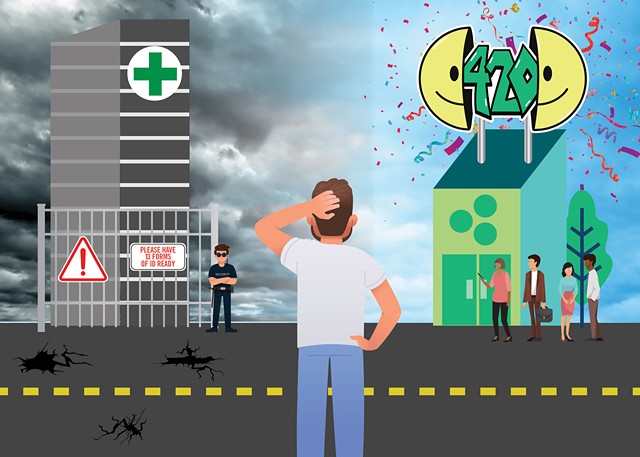
- ILLUSTRATION BY JACOB WALSH
“Even though adult-use cannabis is now legal, the medical cannabis program isn’t going anywhere,” Karen Vanderzyden, a health and safety specialist with the Office of Cannabis Management, told viewers. “I know it’s a concern for our patients. We are committed to maintaining a robust medical program for a lot of reasons. A medical program is necessary.”
Like other medical marijuana programs in states that legalized the recreational use of cannabis, New York’s program is losing participants at a rapid clip — for myriad reasons — despite the passage of legislation that was intended to support and expand the service.
More than 151,000 people registered for the medical marijuana program between its inception in 2014 and 2021, when state lawmakers legalized recreational cannabis, according to the Office of Cannabis Management. Today, the program has 121,000 patients, according to the office.
The downward trend is no aberration. An Annals of Internal Medicine study found that participation in medical marijuana programs declined in five of seven states where recreational cannabis later became legal. For example, Colorado fully legalized cannabis in 2014 and the patient count in its medical program dropped from 94,500 in 2016 to 70,700 this past January. Oregon legalized cannabis in 2015, and between 2016 and 2020 its patient count fell to 22,600 from 68,000.
Pinpointing precisely why registrants in medical marijuana programs fall off the rolls is difficult. But in New York, it is not a stretch to suggest that the limits of the program have been a factor.
The state capped the number of medical cannabis operators at 10, and each was limited to opening four dispensaries. There are 38 dispensaries across the state, and only two of those are in the Rochester region, both of them in the city — Columbia Care on Ridge Road and RISE on University Avenue.
Patients who have traditionally relied on the program may have found more convenient options for their treatment since legalization, even if those options are the unregulated operations now proliferating in corner stores, CBD shops, or as standalone storefronts.
Historically, only a small number of diseases qualified for medical marijuana use, including AIDS, cancer, and epilepsy. Also, patients were restricted from smoking or vaping cannabis flower, which is more affordable than other cannabis variations, and were limited to a 30-day supply.
All of those restrictions were modified under the law that legalized recreational cannabis. Patients can now receive up to a 60-day supply of cannabis, and doctors have the discretion to recommend medical marijuana for any condition.
Lawmakers also allowed each of the 10 medical marijuana operators to open three recreational dispensaries for a fee, as long as they do so in underserved areas. But the law says nothing about how much the fee should be or when it should be set. Early discussions touched on a potential fee of $20 million, and operators have spent millions on lobbyists to lower that figure.
Whether those changes were too little too late for medical marijuana licensees to get in on what some have projected to be a $6 billion market is an open question.
A trade group for several medical cannabis operators, including RISE’s parent company Green Thumb Industries, is suing the state over its process and criteria for awarding recreational dispensary licenses. The state opened the first round of licensing only to New York residents with past marijuana convictions or their parents, spouses, or children. The plaintiffs argue that the state overstepped its authority in doing so.
On social media, some patients have expressed worries that the state’s new adult-use market could stunt or weaken the medical program.
"Patients were a huge part of the advocacy that has helped normalize cannabis and to leave them behind by underinvesting or abandoning the medical program would be a real shame for all of the work that has been done to help folks actually access this medicine,” said Ngiste Abebe, vice president of public policy for Columbia Care, a multi-state medical and adult-use cannabis company.
In states where it’s allowed, Columbia Care operates medical and recreational dispensaries.
"We've seen in other states that without adult-use, medical programs struggle,” Abebe said. “We have 122,000 or 121,000 patients in the entire state of New York so that means all of our dispensaries have a maximum of 121,000 customers, and these are folks who are sick and who don't have the support of insurance coverage to help them access this medicine.”
State Sen. Jeremy Cooney, who supports a robust medical program, said one of the biggest issues he sees with it is affordability.
The cannabis products at medical dispensaries aren’t cheap and health insurance plans don’t cover them, nor are they likely to while cannabis remains illegal at the federal level. The state eliminated the registration fee for patients, but they still have to pay for a doctor’s appointment to get certified, which often costs around $150.
But Cooney does see ways to get prices down. For example, he’s introduced legislation that would get rid of the tax on the products, which he believes would drive down prices.
“We don't tax other kinds of prescribed treatments,” Cooney said. “The glib phrase is, ‘You don't tax Tylenol.’ Well, we don't tax Tylenol because we know that doctors or over-the-counter pharmacists are providing a treatment to reduce a health ailment.”
Jeremy Moule is CITY's deputy editor. He can be reached at [email protected].
